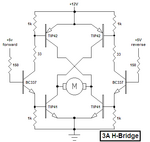dl09
Full Member level 4
i built a h-bridge out of 4 transistors. 1 is an npn transistor. the other 3 are pnp transistor. i connected the h-bridge to a arduino uno microcontroller board. i connected a
hobby electric motor to the h-bridge. i test this circuit many times, the arduino uno microcontroller board will change the polarity of the electric motor. i have not
connected the base of any transitors to any resistors. i did not install any resistors in this circuit. the breadboard has two sets of rails. i think 1 set won't work and the other
set will work. i noticed today 1 transistor did not seem to be working then i moved it to a different spot and it seem to be working now. i am worried i am damaging the breadboard. am i?
here is a schematic

hobby electric motor to the h-bridge. i test this circuit many times, the arduino uno microcontroller board will change the polarity of the electric motor. i have not
connected the base of any transitors to any resistors. i did not install any resistors in this circuit. the breadboard has two sets of rails. i think 1 set won't work and the other
set will work. i noticed today 1 transistor did not seem to be working then i moved it to a different spot and it seem to be working now. i am worried i am damaging the breadboard. am i?
--- Updated ---
here is a schematic
